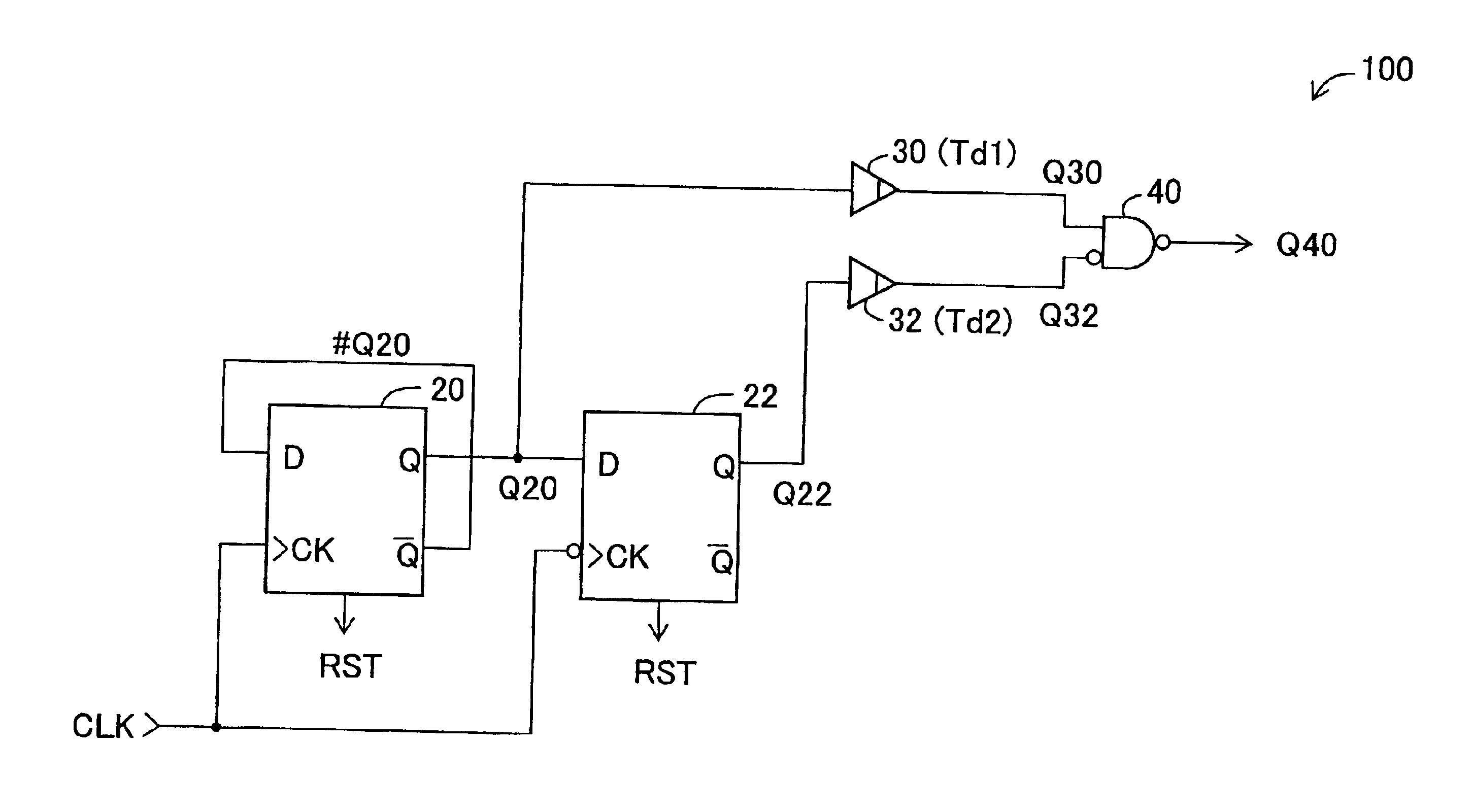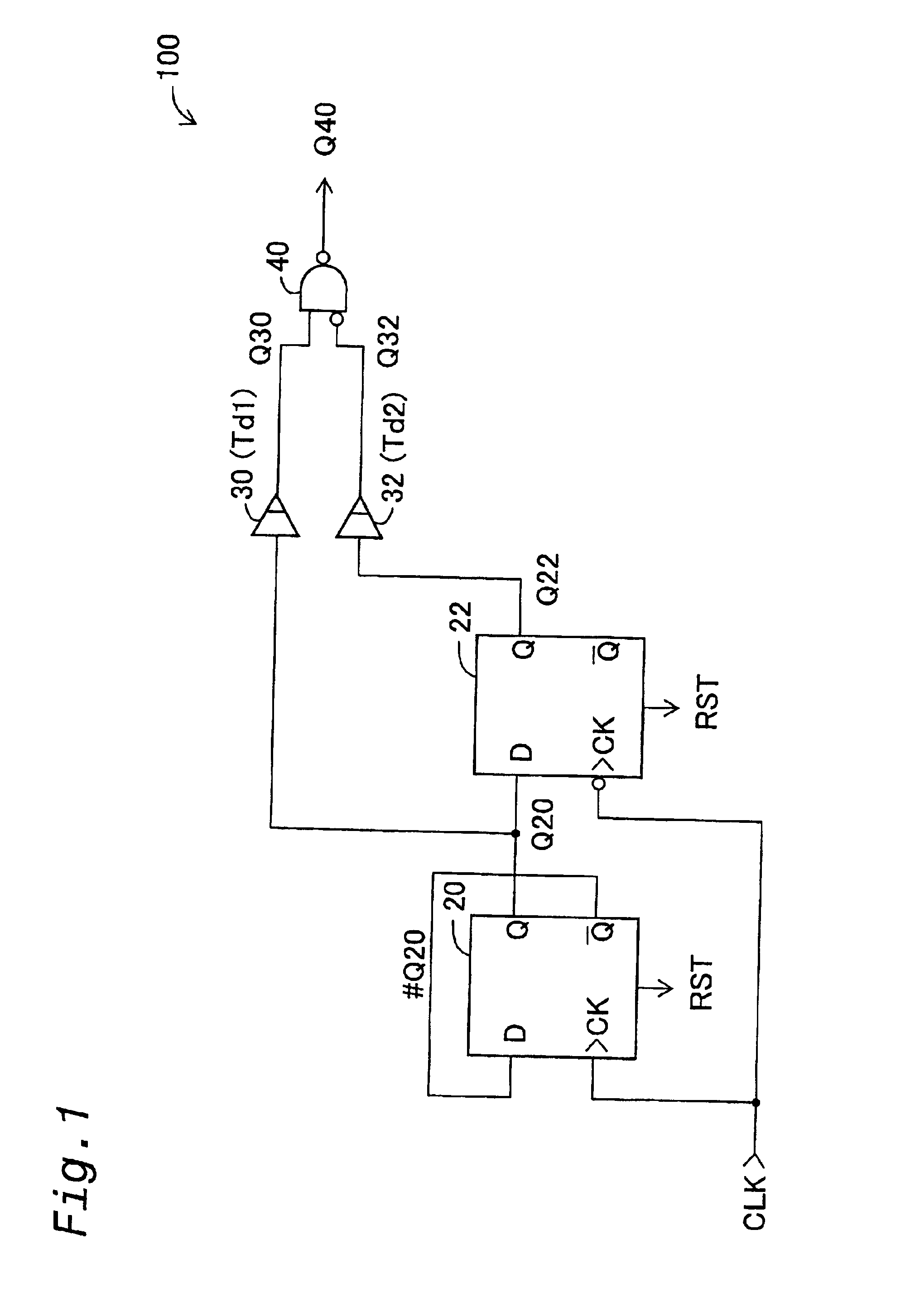Generation of pulse signals from a clock signal
a clock signal and pulse signal technology, applied in the direction of generating/distributing signals, pulse techniques, instruments, etc., can solve the problems of large errors, low cycle duration of clock signals, and disadvantages of conventional pulse signal generating circuits, so as to minimize the effect of delay values and reduce delay values
- Summary
- Abstract
- Description
- Claims
- Application Information
AI Technical Summary
Benefits of technology
Problems solved by technology
Method used
Image
Examples
second embodiment
B. Second Embodiment
[0079]FIG. 7 is a block diagram depicting the structure of a pulse signal generating circuit 110 as a second embodiment of the present invention. The circuit 110 comprises a first-stage circuit 112, a second-stage circuit 114, and an AND gate 50. The first-stage circuit 112 has the same structure as the pulse signal generating circuit 100 of the first embodiment shown in FIG. 1. The second-stage circuit 114 comprises two DFFs 24 and 26, two delay circuits 34 and 36, and a NAND gate 42 in which one of the two input terminals is an inverted input terminal. The connections between the elements of the second-stage circuit 114 are substantially the same as the connections between the elements of the first-stage circuit 112. The delay circuits 34 and 36 in the second-stage circuit 114 have the same delay times Td1 and Td2 as the delay circuits 30 and 32 in the first-stage circuit 112. The D input terminal of the first DFF 24 in the second-stage circuit 114 is supplied ...
third embodiment
C. Third Embodiment
[0083]FIG. 9 is a block diagram depicting a pulse signal generating circuit 120 pertaining to a third embodiment of the present invention. The pulse signal generating circuit 120 is obtained by removing the two DFFs 24 and 26 from the circuit of the second embodiment shown in FIG. 7. Another feature of the circuit 120 is that the inputs of the delay circuits 34 and 36 are different from those of the circuit pertaining to the second embodiment. Specifically, the inverted output of the first DFF 20 is provided to a delay circuit 34 having a first delay time Td1, and the inverted output of the second DFF 22 is provided to a delay circuit 36 having a second delay time Td2.
[0084]The pulse signal generating circuit 120 of the third embodiment can generate substantially the same pulse signal Sout as the pulse signal generating circuit 110 of the second embodiment. Another advantage of the third embodiment is that its circuit structure is simpler than that of the second e...
fourth embodiment
D. Fourth Embodiment
[0085]FIG. 10 is a block diagram depicting the structure of a pulse signal generating circuit 130 pertaining to a fourth embodiment of the present invention. The structure of the pulse signal generating circuit 130 is obtained by removing the two delay circuits 34 and 36 from the circuit of the third embodiment shown in FIG. 9. Another feature of the pulse signal generating circuit 130 is that the output Q30 of the first delay circuit 30 is provided to the noninverted input terminal of a first NAND gate 40 and the inverted input terminal of a second NAND gate 42. The output Q32 of the second delay circuit 32 is provided to the inverted input terminal of the first NAND gate 40 and the noninverted input terminal of the second NAND gate 42.
[0086]The pulse signal generating circuit 130 of the fourth embodiment can generate substantially the same pulse signal Sout as the one generated by the pulse signal generating circuit of the second or third embodiment. Another ad...
PUM
 Login to View More
Login to View More Abstract
Description
Claims
Application Information
 Login to View More
Login to View More - R&D
- Intellectual Property
- Life Sciences
- Materials
- Tech Scout
- Unparalleled Data Quality
- Higher Quality Content
- 60% Fewer Hallucinations
Browse by: Latest US Patents, China's latest patents, Technical Efficacy Thesaurus, Application Domain, Technology Topic, Popular Technical Reports.
© 2025 PatSnap. All rights reserved.Legal|Privacy policy|Modern Slavery Act Transparency Statement|Sitemap|About US| Contact US: help@patsnap.com



